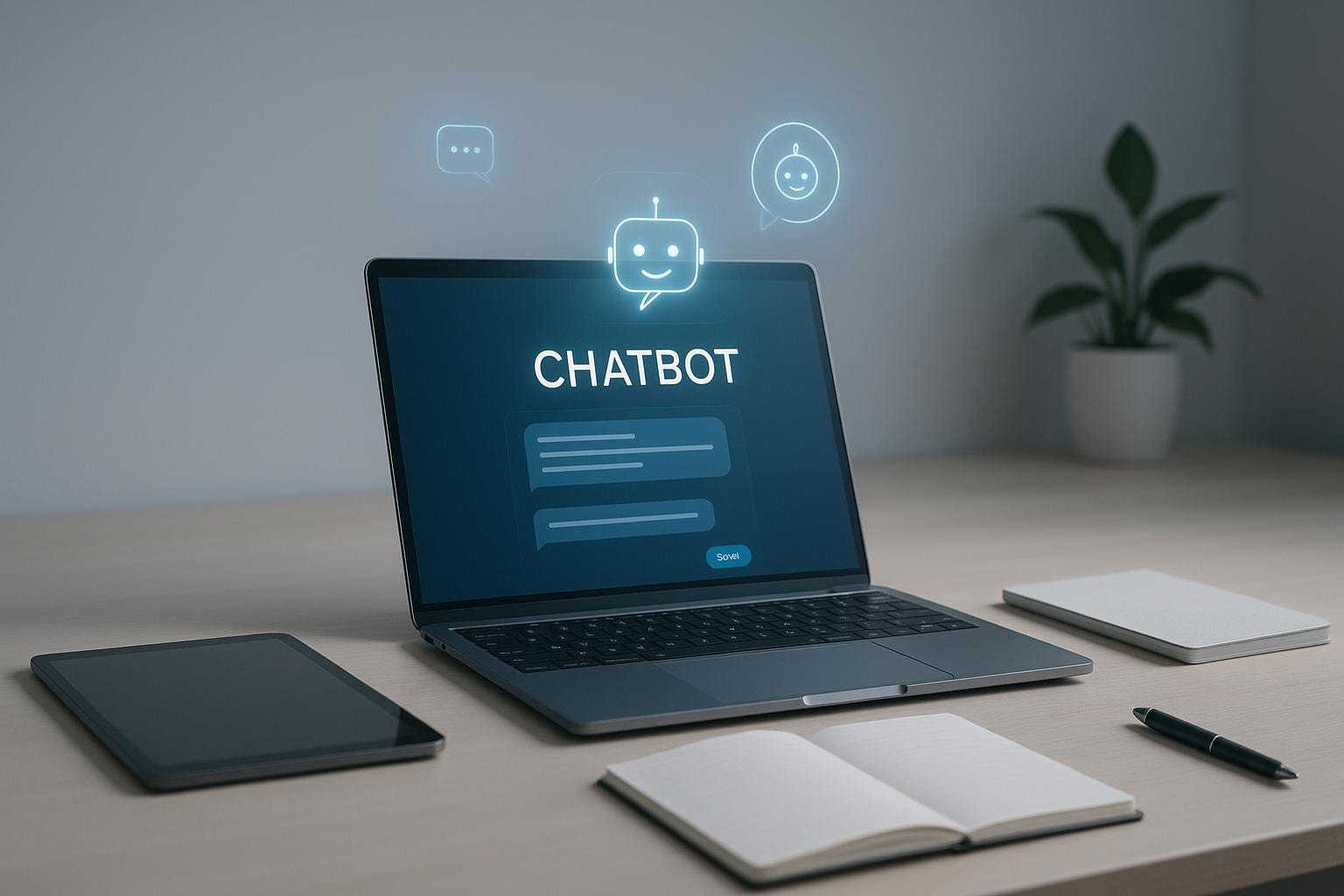
Top 5 Tools for Chatbot Prototyping in 2025
Looking to build a chatbot quickly in 2025? Here’s a list of the top tools that make chatbot prototyping simple and effective:
- Dialzara: Best for voice-based AI, handling phone calls with ease. Quick setup, 24/7 call handling, and integration with 5,000+ apps. Pricing starts at $29/month.
- Chatbase: A no-code platform for text-based chatbots. Drag-and-drop interface, advanced language support, and integrations with tools like Slack and WhatsApp. Free plan available; paid plans start at $40/month.
- Dialogflow: Google’s platform for advanced conversational AI. Excellent for managing complex conversations and integrates seamlessly with Google Cloud. Pricing starts at $0.002 per text request.
- Botpress: Open-source chatbot builder with a visual editor and self-hosting options. Supports multiple AI models and custom integrations. Free and paid plans available.
- Voiceflow: Visual design tool suitable for beginners and professionals. Offers templates, API integrations, and supports custom logic. Pricing starts at $48/month (billed annually).
Quick Comparison
| Tool Name | Best For | Key Features | Starting Price |
|---|---|---|---|
| Dialzara | Voice-based AI | 10-min setup, call handling, integrations | $29/month |
| Chatbase | Text-based chatbots | No-code, multi-language, integrations | Free, $40/month paid |
| Dialogflow | Advanced AI | Google Cloud, multi-language, scalable | $0.002 per request |
| Botpress | Open-source bots | Visual editor, self-hosting, AI models | Free, paid options |
| Voiceflow | Visual design | Drag-and-drop, API integrations | $48/month annually |
Each tool caters to different needs - whether you need voice AI, text chatbots, or advanced customization. Choose one based on your technical skills, budget, and business goals.
1. Dialzara
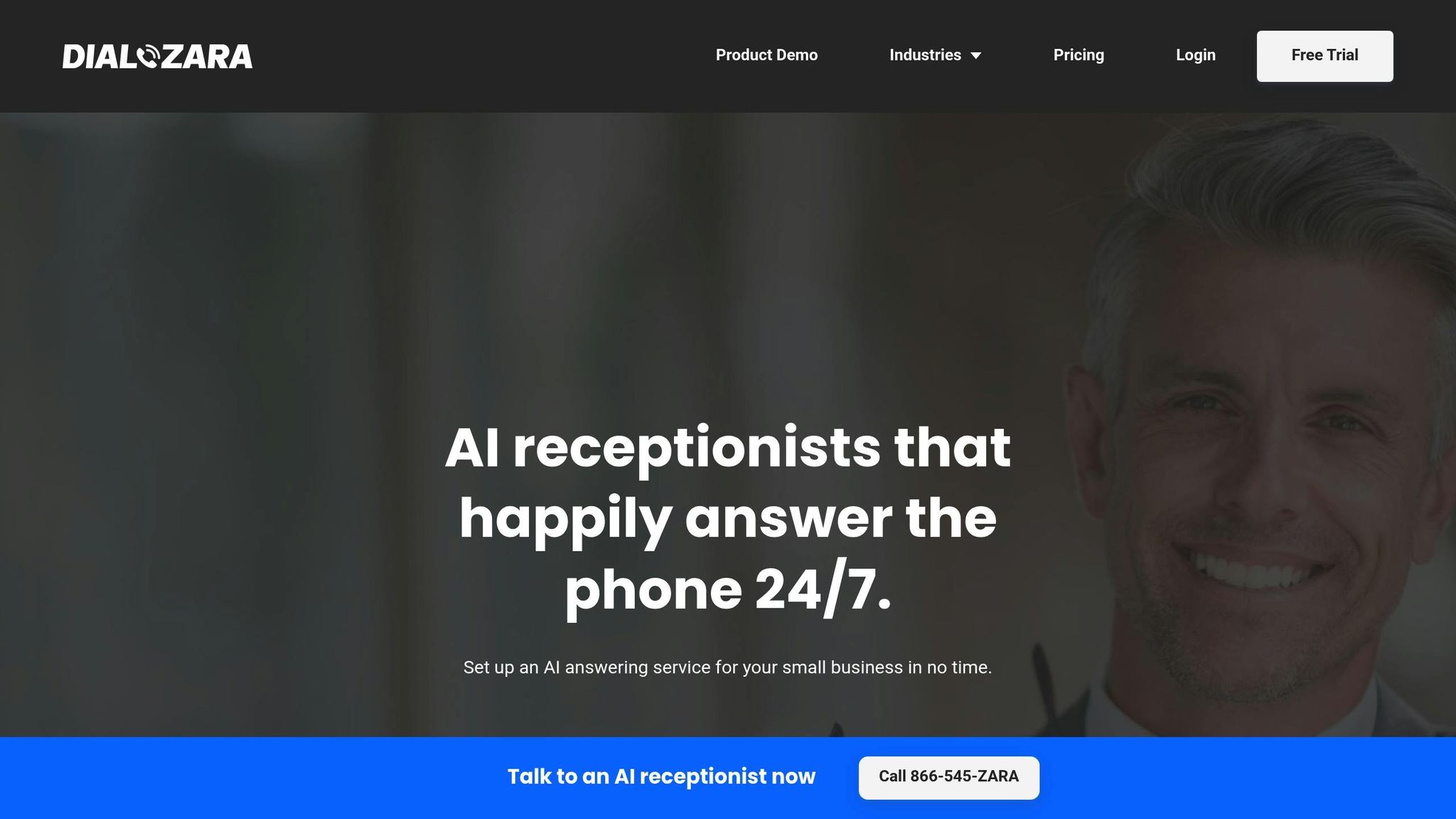
When most businesses think of chatbots, they picture text-based interactions. Dialzara, however, flips the script by focusing on voice-based conversational AI designed to handle phone calls. This approach addresses a major gap: while 60% of customers prefer making calls, only 38% of those calls get answered, and just 20% of callers leave voicemails.
Quick and Simple Setup
Dialzara shines with its easy setup process, which takes less than 10 minutes. The platform automatically transforms your business details into a customized prompt. All you need to do is create an account, answer a few questions, pick from over 40 voice options, choose a dedicated phone number, and set up call forwarding. You can also train the AI by uploading documents, call scripts, recordings, or even URLs to expand its knowledge base.
"One of the best return on investments I've ever made!" – Juan, AI answering service client and owner of AllyzAuto
Seamless Integration
Dialzara doesn’t just stop at being easy to prototype - it also integrates effortlessly with your existing tools. Thanks to its compatibility with thousands of apps via Zapier, you can connect it to calendars, CRMs, and other systems to automate workflows. This eliminates the need for extra development work, making it a plug-and-play solution for businesses.
Built for Growth
As your business scales, so does Dialzara. It’s designed to handle increasing call volumes without breaking a sweat, helping businesses cut operational costs by up to 90%. With AI agents available 24/7 across time zones, it ensures your customers are always taken care of. Dialzara supports a wide range of industries, including legal, transportation, insurance, real estate, healthcare, and financial services, showcasing its versatility.
Human-Like AI Features
Powered by advanced natural language processing (NLP) and speech recognition, Dialzara delivers highly accurate, human-like interactions with a 99.8% success rate. The system continuously learns from client feedback, new terminologies, and interaction patterns, ensuring it gets better over time. By using AI-driven interactive voice response (IVR) to greet callers, guide them through inquiries, and collect important information, Dialzara creates a seamless and engaging customer experience.
"I've found Dialzara to be incredibly efficient and authentic." – Bobby James Fournier
Dialzara’s customization features allow it to understand industry-specific terms and match your brand’s tone, making it feel like a natural extension of your business. Pricing is straightforward, with three plans available: Business Lite at $29/month, Business Pro at $99/month, and Business Plus at $199/month.
2. Chatbase
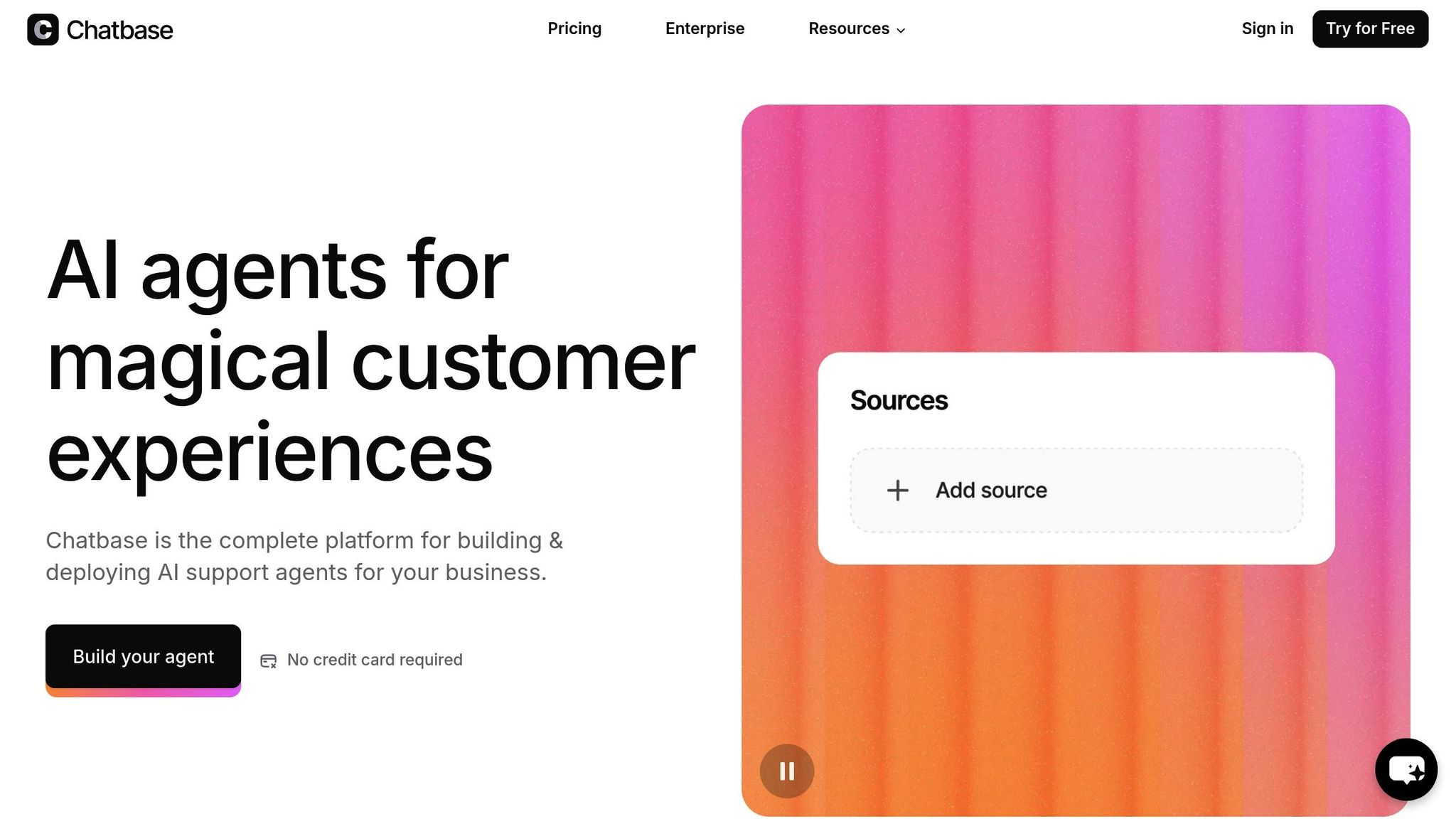
While Dialzara shines in voice-driven AI, Chatbase takes the lead in transforming text-based interactions into seamless customer support solutions. It’s a no-code chatbot builder designed to make creating AI chatbots accessible to everyone - no technical skills required. Thanks to its drag-and-drop interface, users can build functional, AI-powered chatbots without touching a single line of code. With an impressive 88.7% accuracy rate, Chatbase has earned its spot as one of the most reliable platforms in the market.
Easy Prototyping
Getting started with Chatbase is refreshingly simple. You can train your chatbot using data pulled from PDFs, URLs, and other file formats, turning raw information into a smart, conversational assistant. Its visual interface streamlines the process of designing and testing conversational flows, allowing you to prototype quickly. Whether it’s uploading product catalogs, policy documents, or connecting to live data sources, Chatbase ensures your chatbot is equipped to handle real-world scenarios right from the beginning.
Advanced AI and Language Features
Chatbase leverages powerful natural language processing (NLP) to help your chatbot grasp context, subtle nuances, and even user emotions. With support for over 80 languages, it offers real-time language detection, translation, and sentiment analysis. This ensures that every response not only meets user expectations but also reflects your brand’s tone and style.
Flexible Integrations
One of Chatbase's strongest features is its integration flexibility. It connects effortlessly with popular messaging platforms like Slack, WhatsApp, Messenger, and Instagram, enabling you to deploy your chatbot across multiple customer touchpoints. Beyond messaging, it integrates smoothly with business tools such as Zendesk, Notion, Stripe, Salesforce, Calendly, and Zapier. For those requiring deeper system connectivity, Chatbase offers APIs, client libraries, and pre-built components, making it easy to link with CRMs, order management systems, and other business tools. This makes it an ideal companion for businesses that favor text-driven customer interactions.
Built for Growth
As your chatbot evolves, Chatbase is designed to grow with you. Trusted by over 9,000 businesses worldwide, it offers enterprise-grade safeguards to minimize misinformation and off-topic responses. The platform enables bots to respond up to 80% faster, dramatically improving customer satisfaction. Robust analytics tools provide insights into user interactions, helping you fine-tune performance as your chatbot scales to handle larger volumes.
Pricing Options
Chatbase offers a range of pricing plans to suit different needs. It starts with a free plan, which includes one AI agent and 100 messages per month. For more advanced features, plans range from the Hobby plan at $40 per month to enterprise-level options at $500 per month, each offering expanded message limits, additional agents, and more advanced capabilities.
"Chatbase is a strong signal of how customer support will evolve. It is an early adopter of the agentic approach, which will become increasingly effective, trusted, and prominent." - Marc Manara, OpenAI
3. Dialogflow
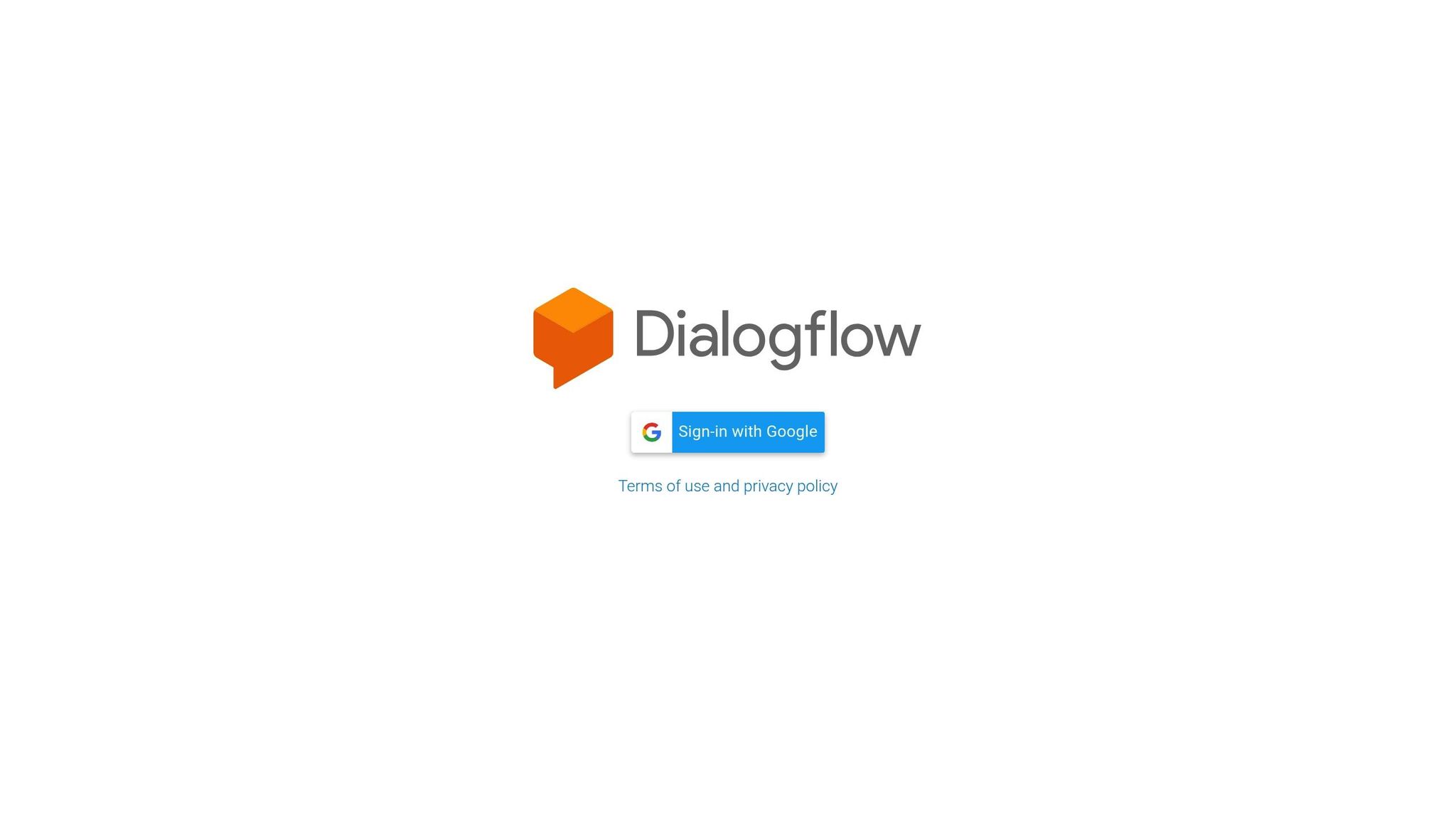
Dialogflow is Google's cloud-based platform designed to simplify the development of chatbots and conversational interfaces. By leveraging natural language understanding and being built on Google's robust infrastructure, it provides a solid foundation for creating bots that can handle even complex interactions.
Ease of Prototyping
Dialogflow offers a low-code environment that streamlines the creation of conversational flows. The CX version takes it a step further with a drag-and-drop editor and prebuilt templates that can be tailored to fit specific needs. Its state machine design ensures clear and manageable conversation paths, making the development process smoother and improving the overall user experience.
AI and Natural Language Features
Powered by Google's advanced language models, Dialogflow excels in accurately detecting user intent and maintaining context, even when users phrase things differently. Recent updates introduced Gemini-2 models, which include a generative playbook and no-code sequence creation. With support for over 95 languages in the ES version and over 25 in CX, along with real-time translation for an additional 50 languages, the platform is well-suited for applications like customer support bots and IVR voice assistants.
Integration Capabilities
Dialogflow's ease of use extends to its integration options. It connects seamlessly with popular platforms like Google Assistant, Slack, and Facebook Messenger. For businesses already using Google's ecosystem, it works effortlessly with Google Cloud Functions, BigQuery Analytics, and Vertex AI. Additionally, it provides connectors for widely used tools such as Salesforce, SharePoint, Jira, and ServiceNow. This broad compatibility makes it easy to connect your chatbot to existing systems.
Scalability and Pricing
Thanks to Google's infrastructure, Dialogflow can handle traffic surges without breaking a sweat, ensuring a smooth transition from prototype to production. Pricing is straightforward: Dialogflow ES costs $0.002 per text request and $0.0065 for every 15 seconds of audio, while CX is priced at $0.007 per text request and $0.001 per second of audio. Enterprise support starts at $10,000 per month.
For developers already working within the Google ecosystem or those needing advanced voice interaction capabilities, Dialogflow remains a reliable and efficient choice for developing chatbot solutions.
4. Botpress
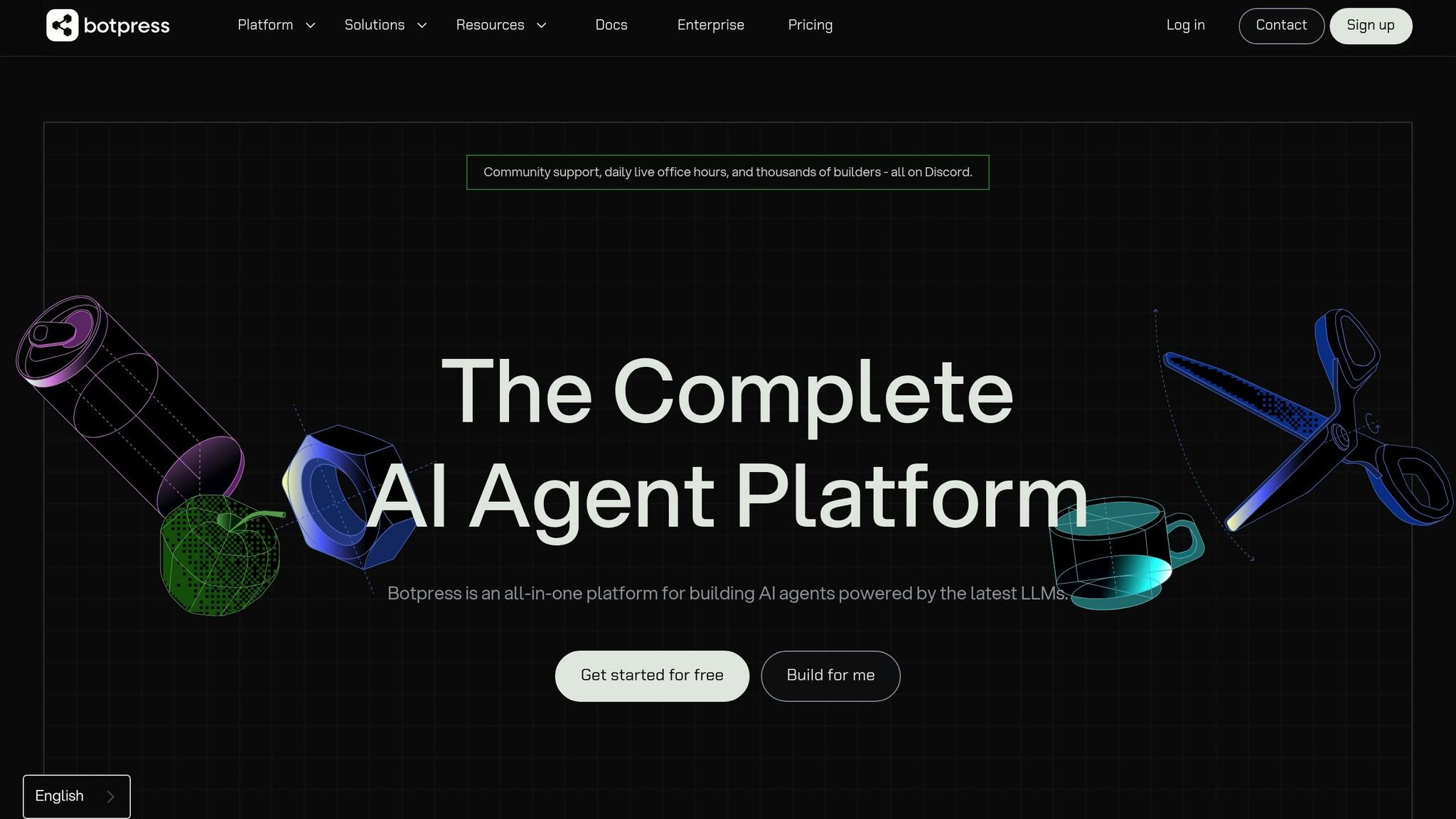
Botpress is an open-source platform designed to handle everything from simple to advanced conversational AI. It provides businesses with a complete toolkit to automate their conversational workflows, making it easier to prototype and deploy AI-powered chat solutions.
Ease of Prototyping
With Botpress, creating conversational flows is straightforward thanks to its visual Flow Builder. This tool lets users design conversations by connecting nodes and defining responses, eliminating much of the complexity involved in coding from scratch. The platform also supports quick development with flexibility, including self-hosting options.
AI and Natural Language Features
Botpress integrates AI capabilities powered by ChatGPT and supports a range of large language models such as OpenAI's ChatGPT, Claude, Google's Gemini, DeepSeek, and LLama. This variety allows users to test different AI functionalities during prototyping. Its DynamicNLP™ feature ensures accurate intent recognition while supporting multiple languages. Impressively, as of June 2024, over 750,000 active bots on the platform had processed more than 1 billion messages. The Autonomous Node feature further enhances functionality by enabling the AI to decide the sequence and timing of actions, creating more natural, context-aware conversations.
Integration Capabilities
Botpress excels at integration, offering pre-built connectors and a Messaging API that links to CRMs, databases, and knowledge bases. Its open-source framework also allows for custom integrations with almost any third-party system.
"The unlimited number of integrations is perfect for any type of workflow - cancellations, refunds, authentications, and more!"
This flexibility is evident in real-world applications. For instance, Waiver Consulting Group developed a Botpress-powered AI agent named Waiverlyn in just three weeks to handle lead capture, qualification, and consultation bookings. Similarly, Able, a health coaching platform, implemented an AI chatbot that cut manual support tickets by 65%, saving over $50,000 annually on support costs.
Scalability
Botpress is built to scale, making it a strong choice for companies looking to grow their AI capabilities. Its infrastructure supports production-level AI agents, as demonstrated by businesses like Ruby Labs, which use Botpress to manage millions of monthly support chats. These AI agents not only resolve a high volume of inquiries but also proactively identify risky behaviors. With 50% of organizations planning to automate their processes and AI adoption leading to a 52% reduction in labor costs, Botpress provides a scalable solution for expanding conversational AI needs.
sbb-itb-ef0082b
5. Voiceflow
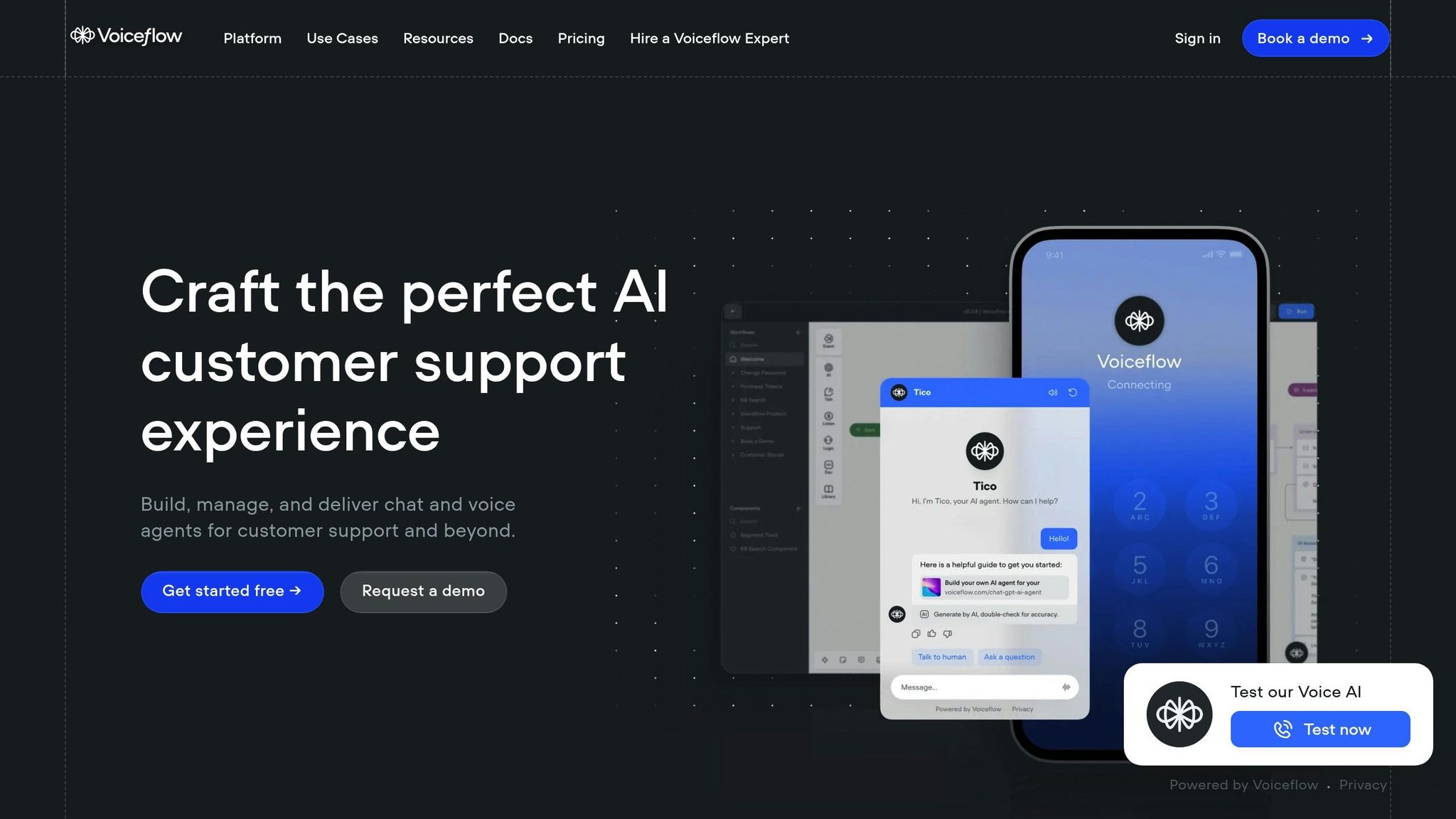
Voiceflow brings together visual design and development tools to help users prototype conversational AI, catering to both beginners and experienced professionals.
Ease of Prototyping
With its visual designer and drag-and-drop interface, Voiceflow makes it easy to create and tweak even the most intricate conversational flows. You can also integrate custom JavaScript functions to add advanced logic to your designs. Plus, its library of templates helps speed up the setup process. This straightforward approach transitions smoothly into Voiceflow's more advanced AI tools.
AI and Natural Language Features
Voiceflow uses natural language processing (NLP) to help its AI agents understand and respond to human language. These agents can follow instructions, perform tasks, and reply automatically using built-in knowledge bases. The platform supports intents and entities, allowing for context-aware conversations. Chatbots can also be trained on various data sources, such as plain text, website links, and Zendesk Helpdesk articles. A KB search block integrates learned data directly into conversation flows. Additionally, users have the option to bring their own large language model (LLM) and set up fallback mechanisms.
Integration Capabilities
Voiceflow connects with over 300 platforms, including CRMs, databases, and automation tools, thanks to its developer APIs and a strong Zapier integration. Its flexibility is evident in real-world use cases: eSnipe used Voiceflow to automate 70% of its help center tickets with an AI-powered search box, while Toplyne built custom chat interfaces that go beyond traditional chat bubbles. These integrations make it easy to scale a prototype into a fully functional solution.
"Voiceflow is a very versatile tool, combining visual flows with strong API capabilities and also providing a code editor and functions, for developers."
- Ciprian Nastase, L3 Support AI Engineer
Scalability
Voiceflow stands out when it comes to scaling. For instance, Sanlam launched an AI financial assistant three times faster, and Trilogy resolved 70% of its support tickets, saving $425,000 in just 90 days. The platform's enterprise-level cloud infrastructure ensures secure, reliable performance for production workloads. Pricing is flexible, with the Pro plan at $60/month per editor (or $48/month annually) and the Team plan at $125/month per editor (or $100/month annually).
"Voiceflow provides us with massive acceleration, enabling us to experiment without fear... Voiceflow allowed us to focus on value-adding activities like orchestration and building a robust, generative conversational architecture."
- Andre Fredericks, Chief Operating Officer
Tool Comparison Chart
Selecting the right chatbot prototyping tool hinges on your specific goals, technical skills, and business demands. The chart below outlines the main features, benefits, and drawbacks of each platform, helping you make an informed choice.
| Tool Name | Key Features | Pros | Cons |
|---|---|---|---|
| Dialzara | AI voice technology, integration with over 5,000 business apps, 24/7 call handling, appointment booking | Quick deployment with tailored, industry-specific solutions that blend into your business | Primarily designed for phone-based interactions |
| Chatbase | AI-powered no-code chatbot builder | User-friendly and adept at understanding user intent | - |
| Dialogflow | Natural language processing, Google Cloud integration, multi-platform deployment, enterprise-grade infrastructure | Excels at managing complex conversations and integrates deeply with Google services | - |
| Botpress | Visual flow editor, built-in natural language understanding, open-source architecture, self-hosting options | Suitable for both developers and non-technical users, offering full control over data | - |
| Voiceflow | Visual designer and template library | Low-code interface designed for speed, perfect for teams with limited coding expertise | - |
The table highlights each tool's core features, but let's dive into their strengths in more detail.
Ease of use is a key factor. Tools like Voiceflow and Botpress are ideal for those seeking low-code, intuitive interfaces. Dialzara stands out for its rapid setup, while Dialogflow may require more technical expertise.
When it comes to scalability, the platforms offer different advantages. Dialogflow leverages Google Cloud for seamless scaling, Botpress supports self-hosting for greater control, and Dialzara ensures constant, reliable performance through its cloud-based infrastructure.
Integration capabilities also vary. Dialogflow connects deeply within Google's ecosystem, Botpress provides flexible custom integrations, and Dialzara integrates with over 5,000 business applications, making it a versatile choice for diverse needs.
As the chatbot industry is projected to reach $1.25 billion by 2025, and with 62% of customers preferring chatbot assistance before turning to human support, selecting a platform that can handle growing demands is increasingly important.
Conclusion
When choosing a prototyping tool, it's essential to weigh several key factors to ensure the platform aligns with your needs.
Start by assessing your technical expertise and the platform's complexity. For those with minimal coding experience, tools like Voiceflow and Chatbase provide user-friendly interfaces. On the other hand, Dialogflow and Botpress cater to teams with advanced technical skills, offering extensive customization options. If voice-based interactions are a priority - such as in healthcare, legal services, or real estate - Dialzara stands out as a specialized solution. Scalability is another critical consideration, as startups often prioritize quick deployment, while larger enterprises need platforms capable of managing millions of conversations. Additionally, integration with existing business applications is a must for seamless operations, as highlighted in the comparison chart.
Budgeting is equally important. Developing a chatbot can cost anywhere from $5,000 for a basic setup to over $100,000 for more advanced, AI-powered solutions. Be sure to account for initial setup fees, ongoing maintenance, scaling costs, and any customizations you might need as your business grows.
Finally, test the platform in a real-world scenario. Use your specific use case to prototype, evaluate the user experience, and confirm the platform can handle your expected interaction volume. This practical approach ensures the tool meets your operational demands.
Many businesses begin with simpler tools and transition to more advanced platforms as their needs expand. Choose a solution that addresses your current requirements while offering a clear path for future growth.
FAQs
What should I look for when selecting a chatbot prototyping tool for my business in 2025?
When choosing a chatbot prototyping tool in 2025, prioritize tools that are easy to use and come with AI-powered features like natural language processing. It's also essential to ensure the platform integrates smoothly with your existing systems and messaging platforms. Plus, look for tools that can scale alongside your business as it grows.
Key considerations should also include multi-language capabilities, strong security measures, and the flexibility to deploy on various platforms. If your business handles sensitive data or manages a high volume of customer interactions, opt for tools that provide detailed analytics and enterprise-level performance. Ultimately, the tool you select should simplify your processes and align seamlessly with your business objectives.
How do integration features make chatbot tools more effective for businesses?
Integration features have transformed chatbot tools, making it possible for them to connect effortlessly with the systems and applications your business depends on. This simplifies workflows, reduces repetitive tasks, and ensures chatbots have the data they need to deliver real-time, tailored responses to customer questions.
For example, when connected to tools like CRM platforms or scheduling software, chatbots can manage a larger number of inquiries, transfer calls, schedule appointments, and even update records automatically. This approach not only boosts customer satisfaction but also streamlines day-to-day operations, helping your team save time and resources while maintaining top-notch service quality.
What should businesses consider when budgeting for chatbot prototyping tools?
The price tag for chatbot prototyping tools can vary widely - starting at a few thousand dollars for simpler solutions and climbing above $250,000 for more advanced AI-driven platforms. How much you'll need to spend depends heavily on your specific requirements, like the chatbot’s complexity, the features you want, and how scalable the system needs to be.
When setting your budget, don’t just focus on the upfront development costs. You’ll also need to account for ongoing expenses, such as maintenance, updates, and integrating the chatbot with your existing systems. Factoring in these elements early on can help you strike the right balance between functionality and cost, ensuring your investment delivers value over the long haul.
Related Posts
Top 7 Chatbots for Social Media Engagement 2024
Explore the top chatbots for enhancing social media engagement in 2024, featuring AI-driven solutions for personalized interactions.
12 Best AI Customer Service Platforms 2024
Discover the top 12 AI customer service platforms for 2024 that offer automation, personalized support, and cost savings. Find the best platform for your business needs.
12 Best AI Customer Service Tools 2024
Discover the top 12 AI customer service tools for 2024 with key features, pricing, and deployment details. Stay informed about future trends like enhanced automation and predictive analytics.
10 Best AI Customer Service Analytics Tools 2024
Explore the top 10 AI customer service analytics tools for 2024, benefits of AI in customer service, key features to consider, user ratings, pricing models, and expert insights. Choose the right tool for personalized support, efficient operations, and improved satisfaction.
